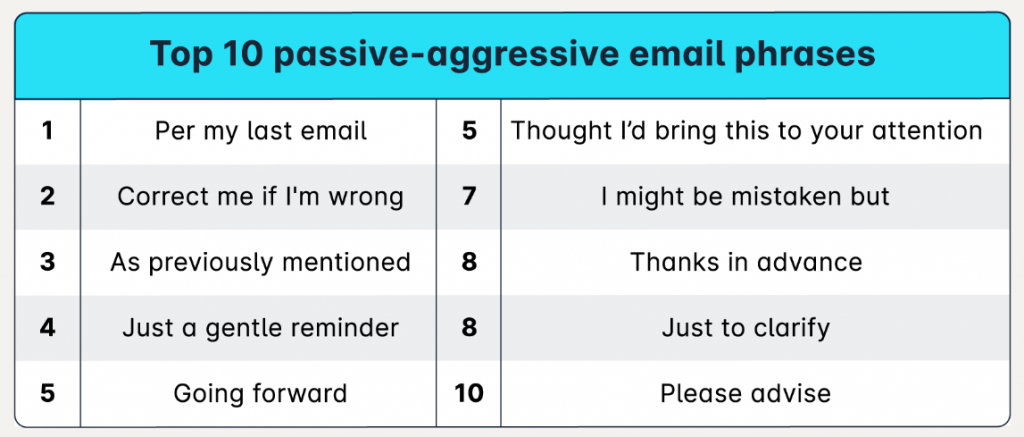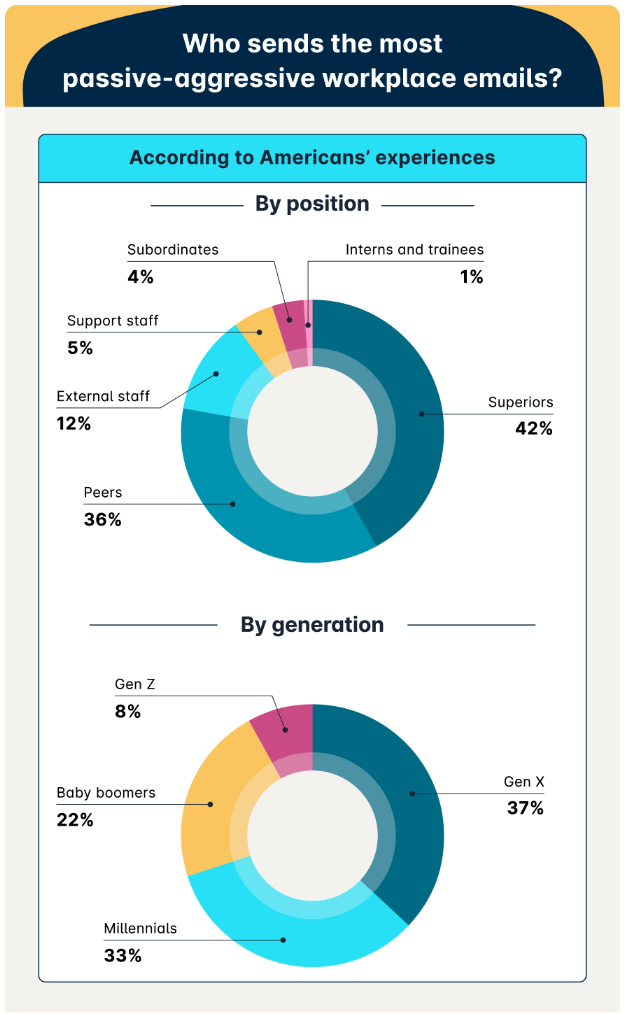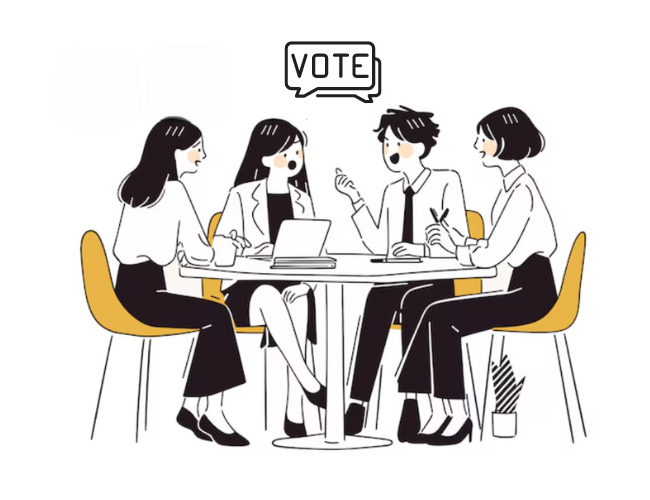This phenomenon can subtly disrupt even the most well-intentioned exchanges, and its prevalence is alarming. 83% of Americans encounter passive-aggressive emails from co-workers, according to Preply’s recent survey.
As the scales tip further toward digital interactions in the professional landscape, understanding the dynamics of passive aggression in written formats is crucial to protecting workplace well-being. This article covers common characteristics of passive-aggressive language, explores the reasons and consequences of its usage, and offers strategies to cultivate a healthier work environment.
Pressed for time? Here’s a quick summary…
- Defining passive aggression: Passive-aggressive communication is characterized by subtle expressions of negativity or hostility, often masked with seemingly harmless language.
- Factors that fuel passive aggression: Employees who are conflict-averse, under high stress, or have previously been subjected to passive aggression are more prone to exhibit this behavior. This cycle perpetuates as past experiences shape their defensive communication strategies, leading to an environment where passive aggression becomes a coping mechanism.
- Consequences of passive-aggressive behavior: Passive aggression can create an emotionally draining workplace, elevating stress and anxiety levels and ultimately hindering productivity.
- Strategies for healthier communication: To mitigate passive aggression and cultivate a healthier work environment, leaders must model positive communication standards, designate a forum for open dialogue, and implement training programs for conflict resolution, emotional intelligence, and stress management.
Decoding Passive Aggression In Written Communication

Passive-aggressive communication is characterized by subtle expressions of negativity or hostility, often masked with seemingly harmless language. It’s worth noting that this form of communication can be unintentional, stemming from miscommunication or a lack of awareness rather than deliberate intent. Common traits of passive-aggressive communication include:
- Unnecessary Reminders: This involves reiterating information in a way that implies the recipient’s neglect or incompetence. Phrases like “per my last email” suggest that the recipient may have overlooked or ignored previous communication, implying their negligence.
- Ignoring Or Minimal Responses: Minimal or dismissive replies can indicate disinterest or dissatisfaction with the conversation. For instance, “correct me if I’m wrong” may be used to dismiss the recipient’s input, implying that their response is unimportant or incorrect.
- Overly Formal Language: Using excessively formal language in casual or routine communication can create a sense of distance or disapproval. Phrases like “as previously mentioned” and “please advise” can make a conversation unnecessarily formal, suggesting a lack of warmth or openness.
- Negative Tone: Passive-aggressive communication often carries a subtle negative tone, which can manifest as polite language masking frustration or annoyance. For example, “Just a gentle reminder” may sound kind but actually conveys impatience or annoyance.
- Non-Humorous Sarcasm: Non-humorous sarcasm has a subtle undertone that contradicts the literal meaning of the words. For instance, “Thanks in advance” might hint that genuine gratitude isn’t anticipated but rather compliance is expected.

Keep in mind that not all instances of these communication traits are necessarily intended to be passive-aggressive. Context plays a significant role in interpretation. While these characteristics can be indicative of passive-aggressive behavior, they can also be used genuinely or innocently in different contexts.
Why Do Employees Resort To Passive-Aggressive Communication?

Understanding the underlying reasons behind passive-aggressive communication in the workplace is key for addressing the issue effectively. Several factors contribute to this behavior:
- Communication Style: Employees who favor indirect communication may use subtle hints or veiled messages to express their needs. Unlike direct communicators, who often openly and straightforwardly express their feelings, indirect communicators may unconsciously succumb to passive-aggressive tactics.
- Stress: Employees under stress may resort to less considerate communication. According to the Preply survey, an overwhelming 94% of employees believe that a sender’s own stress contributes to their passive-aggressive language. Nearly one-fifth of employees admit to sending passive-aggressive emails to their superiors, with most acknowledging that they intentionally use such language in high-pressure situations.
- Reciprocation: Passive-aggressive behavior appears to be contagious, with 80% of employees avoiding direct confrontation with their passive-aggressive colleagues, and half of them taking an “eye for an eye” approach by reciprocating with a similar tone in response.
- Generational Nuances: Gen X and millennials (42%) and Gen Z (36%) are more likely to admit to sending passive-aggressive emails than Baby Boomers (29%). These generational differences can be attributed to heightened self-awareness regarding digital communication among younger generations.

Being aware of these contributing elements can aid in developing strategies to mitigate passive-aggressive communication in the workplace.
Ripple Effects Of Passive-Aggressive Emails
Considering the broader consequences of passive-aggressive communication is essential for understanding its full impact on the workplace:
Impact On Employee Well-being
Like a virus, passive-aggressive communication is contagious and can infect employee well-being. Almost half of respondents have received passive-aggressive emails from their superiors, and 65% noted that coworkers who initially appear friendly in person often turn passive-aggressive through email.
This stark shift in tone can create an emotionally draining work environment, contributing to feelings of frustration, anxiety, and overall job dissatisfaction. For 23% of respondents, this detrimental environment prompted them to quit their jobs.
Link To Heightened Stress Levels

The passive-aggressive cycle perpetuates feelings of tension and anxiety, escalating stress levels. Employees in certain sectors, such as advertising and government, showed higher tendencies to send passive-aggressive emails, potentially reflecting heightened stress levels within these industries.
Impact On Workplace Productivity
Passive-aggressive patterns can be detrimental to overall workplace productivity. The survey indicates that 66% of respondents felt that passive-aggressive emails induced anxiety potent enough to hinder their performance at work.
Acknowledging these adverse impacts is the first step toward creating a healthier, more positive work environment.
Strategies For Healthier Communication In The Workplace

Creating a healthier communication environment is a responsibility that falls on both leadership and individual team members. Here are some strategies to consider:
- Create Awareness: Often, passive-aggressive language and behavior stem from unconscious habits or a lack of awareness. Educating employees about the subtle signs and consequences of passive-aggression may help them catch themselves in the act and consciously choose more constructive communication methods.
- Lead By Example: Managers are perceived to send the most passive-aggressive emails (42%) of all positions. This tendency can have a trickle-down effect and normalize passive-aggressive behavior in the workplace. Effective communication starts from the top, making it critical for leaders to model positive communication standards. By doing so, they can help minimize the prevalence of passive aggression in the workplace.
- Encourage Open Dialogue: Establish regular one-on-one meetings and feedback sessions where employees can freely express their thoughts, concerns, and needs. Designated forums where open dialogue is encouraged can reduce the occurrence of passive-aggressive behavior in the workplace.
- Offer Conflict Resolution Training: Effective communication skills aren’t universally innate. Employers can support their workforce in developing these skills by implementing conflict resolution and emotional intelligence training programs. These are essential skills for navigating workplace relationships and ensuring operations run smoothly.
- Promote A Culture Of Well-Being: Fostering a culture that values mental health and offers accessible stress management resources may reduce instances of passive aggression, promoting a healthy and positive work environment.
It is important to exercise patience, as changing a workplace culture can be a long-term endeavor requiring persistent, ongoing efforts. Both leadership and employees must share a commitment to create a more positive and communicative environment, which ultimately paves the way for open discussions and a harmonious work setting.












